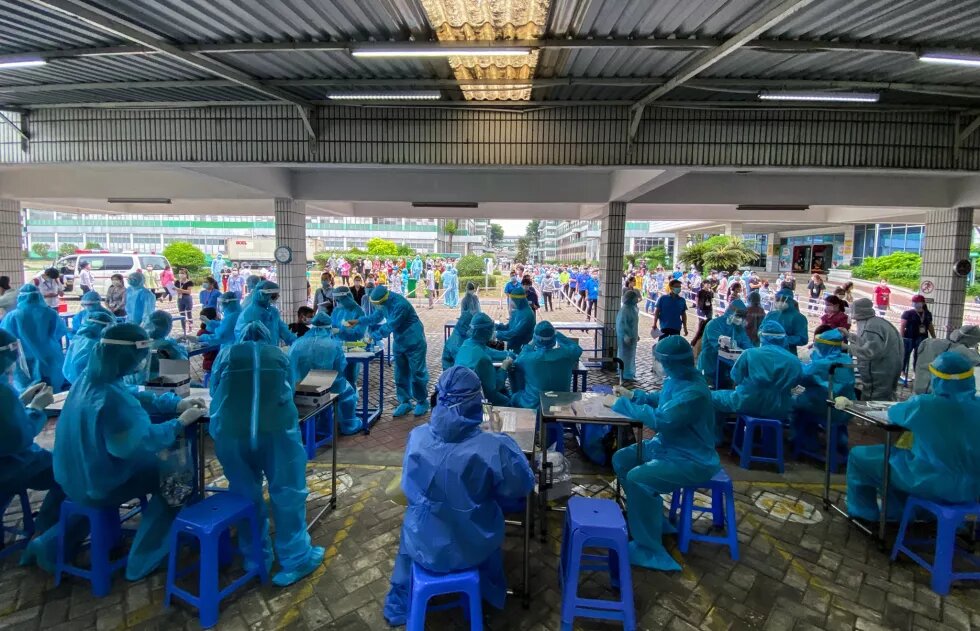
Southeast Asia is struggling to contain the spread of COVID-19 amid a resurgence driven by the Delta variant, leaving national governments with no capacity to spare on neighbouring countries. At the same time, ASEAN faces a trust problem due to the intangible nature of regional cooperation, and capacity issues associated with the prolonged deadlock over the selection of a special envoy to deal with the political crisis in Myanmar. Nevertheless, the potential for future regional cooperation after the health crisis subsides is within view.

This article is also published in Perspectives Asia #10: Fabric of Society
National or regional actions?
In March 2020 the World Health Organization (WHO) officially declared the COVID-19 outbreak a pandemic. This lent urgency for ASEAN governments to come up with a regional response to serve multiple needs: primarily to reassure the respective populaces in ASEAN countries, and to coordinate across multiple sectors to address health, information, financial, and security aspects of the pandemic. Prior to March 2020, COVID-19 had been viewed largely as a domestic, and at most bilateral, matter. In fact, this emphasis on the domestic nature of the response would prevail up to the convening of the Special ASEAN Summit on COVID-19 in July 2020 and even well beyond the establishment of the COVID-19 Response Fund and the adoption of the ASEAN Comprehensive Recovery Framework at the 37th ASEAN Summit in November 2020.
The discrepancy in regional and national-level actions probably stems from the way in which the pandemic affected each ASEAN member state. The pandemic’s threat to regional economies propelled ASEAN to mobilize its regional health governance mechanisms, which had been developed and tested since the SARS and Avian Flu outbreaks in 2003-04. Even so, the rapidity with which infections spread across communities and borders, and the severity of the respiratory illness, took a heavy toll across the region. The economic impact of the pandemic was further compounded when the world started locking down, slowing global economies, disrupting global and regional supply chains, and affecting employment, consumption and investment around the world.
COVID-19 responses in ASEAN
Most of Southeast Asia managed to avoid the brunt of the pandemic for most of 2020 by swiftly closing borders and restricting movement. Data visualization from Our World in Data shows the spread of the pandemic across communities and countries in the region (Fig 1) and the intensity of various Southeast Asian countries’ responses to COVID-19 (Fig 2).1 This “Stringency Index” for Southeast Asian countries is based on the Oxford COVID-19 Government Response Tracker. It reflects common policy responses in ASEAN member states, ranging from public information campaigns and movement restrictions, to the closing of schools, workplaces and public places, as well as near-total lockdowns, strict contact-tracing, quarantine and reporting requirements, as well as domestic and international travel controls.
The graphs show that as a first response to the pandemic, most ASEAN countries reacted by adopting highly restrictive measures during the period from March to May 2020. Many people have attributed the initial successful containment of the virus in the region to these hard measures. However, these containment strategies were not so successful when faced with new virus variants amidst efforts to reopen economies. Indeed, infection figures rose in most ASEAN countries at different times in 2021. The Government Response Tracker has also developed a number of other indices to track policy responses not reflected in these charts, such as those related to testing, contact tracing, healthcare and vaccine investment and measures to mitigate the socio-economic impact of COVID-19, including income support and debt relief, which may or may not include access to or support from the ASEAN COVID-19 Response Fund.
Vaccination challenges, resurgence and a hindered recovery
Vaccination against COVID-19 is a core part of national policies and responses to the disease. Authorities view vaccination as the means to a triple protection: to prevent the disease itself, reduce the risk of transmission, as well as to keep the national healthcare system from being overwhelmed. While governments rushed to secure vaccine doses to inoculate entire populations, the cost of the vaccine has also led to an imbalance in access and distribution not only among countries, but also among communities within countries. Vaccination programmes globally largely follow a phased approach by age, after prioritising those on the frontline confronting the disease on a daily basis. This has also been the approach adopted by ASEAN governments.
Several ASEAN states had rolled out vaccination programmes by March 2021. At that time, regional analysts started predicting a V-shaped or W-shaped economic recovery for Southeast Asian countries. However, shortly afterwards, new variants of the virus and a resurgence of cases in several ASEAN member states delayed hopes of declaring the region open for business or returning to pre-pandemic activities.
Across the region, the uncertainties of COVID-19 virus mutations, the drawn-out duration and the rapid and extensive spread of the pandemic strained public health and public communications systems, adding to perceptions of slow responses and frustrations over the limited capacity to stem the rising number of infections and deaths in several ASEAN countries.
The varying stages and efficacy of responses to the pandemic in each member state reflects the diversity of ASEAN in terms of governance, resources available to deal with the pandemic’s multi-faceted challenges, health system resilience and capacity, and public trust.
Singapore stands out as a leader in vaccination, implementation of stringent measures to prevent and trace the spread of new variants and infections, and in sharing medical equipment and supplies to fellow ASEAN members such as Indonesia and Myanmar.
In Myanmar, a devastating third wave of COVID-19 has compounded the humanitarian crisis catalysed by the military coup on 1 February 2021. The military junta stated that it would continue the vaccination programme started by the National League for Democracy government in January 2021, but implementation and reporting of new cases has been patchy at best, and a major wave of infections has overwhelmed the health system by mid-2021.
Public trust in government efficacy to manage the COVID-19 stresses on the economy and society have also played out in different ways. The political relevance and survival of leaders in Thailand and Malaysia have been largely affected by their COVID-19 response performance. The performance approval of governments in Indonesia, Vietnam, Brunei, Laos and Cambodia do not seem to have been adversely affected. In the Philippines, which had imposed “one of the world’s longest and strictest lockdowns”, the economic recovery outlook lags behind the projected recoveries of Indonesia, Thailand and Vietnam.
An ASEAN senior official (speaking on anonymity) has shared an observation that given ASEAN’s diversity, the regional-level responses to the pandemic would take on a complementary role to the primary responsibility and prominence of each member state’s national response and efforts to address the multi-faceted challenges of the pandemic.
With Southeast Asia – and ASEAN members – now at the epicentre of a new COVID-19 surge in 2021, ASEAN will need to reinforce its earlier regional cooperation commitments for the pandemic response, financially as well as in programme and policy coordination towards recovery. Setting new precedents for cooperation? The unprecedented nature of COVID-19 caused ASEAN to move to a virtual platform for the first time in its 50-plus years of existence. During the SARS outbreak, officials still travelled to various ASEAN cities to hold consultations on dealing with the socio-economic fallout from the epidemic. But not so with COVID-19. Vietnam's 2020 ASEAN chairmanship became the testing point and benchmark for how ASEAN could function solely via online communications during a public health crisis such as COVID-19.
Many important regional health governance mechanisms were also employed as components of ASEAN’s collective response to the pandemic. High-level ASEAN meetings, at both ministerial and summit level, discussed regional measures, not just in the health but also in economic and social sectors, to tackle various aspects of the pandemic. In addition to the COVID-19 Response Fund, the establishment of the ASEAN Centre on Public Health Emergencies and Emerging Diseases in November 2020, as well as the ASEAN Emergency Operating Centre Network for Public Health Emergency and the ASEAN BioDiaspora Virtual Centre, contributed to the regional response, facilitating timely and accurate exchanges of information, and technical support and expertise for laboratories in member states. ASEAN also took on the “infodemic” challenge, and deployed the ASEAN Risk Assessment and Risk Communication Centre to combat misinformation and fake news, as well as disseminating important information on preventive measures to minimize and stop the spread of COVID-19.
The comprehensive scope of the regional efforts thus shows ASEAN’s collective will and commitment to contain COVID-19. But as is the habit of realizing regional commitments, the responsibility to implement is national. Effective national responses require strong leadership, centralized and/or better-coordinated multisector national pandemic taskforces, clear and concise public information, and strict enforcement of public health and other measures to contain the spread. The nature of the pandemic foregrounded such national commitments and responses - to reassure the respective populaces in ASEAN countries and boost confidence in the government’s actions. ASEAN countries also negotiated vaccine access and other cooperation bilaterally more than regionally, with various international, multilateral, and bilateral interlocutors. This approach may need some recalibration, with new variants threatening the road to recovery. A patchwork of bilateral agreements will also need to be worked out for travel and health policy coordination across the region.
Regional measures, which provided the foundation for various national responses and policies, are not immediately visible on the ground compared to national measures and bilateral cooperation for vaccine access. Areas where coordinated regional action will be necessary long after countries reach herd immunity include labour mobility, employment, education, livelihood/ survival conditions, and coping with existing and emerging social issues/concerns. In some instances, the social compact may require rebuilding altogether. Regionally, ASEAN took a first step with its rapid assessment report on COVID-19 impact on livelihoods, issued in December 2020. As is wont of regional cooperation optics, however, many in this region will only see a row of ducks serenely gliding across the water, but not the ducks’ feet paddling furiously beneath the surface.
__
Click to watch the Online Launch Event of Perspectives Asia #10 by Heinrich-Böll-Stiftung Hong Kong Office.
Perspectives Asia #10 : Fabrics of society – Living through the Pandemic - Heinrich-Böll-Stiftung Asia Global Dialogue
 Watch on YouTube
Watch on YouTube
__
Moe Thuzar is an ISEAS-Yusof Ishak Institute Fellow, and co-coordinator of the Myanmar Studies Programme. She was previously a lead researcher at the ASEAN Studies Centre at ISEAS. She joined ISEAS in 2008, after ten years at the ASEAN Secretariat, heading the Human Development Unit in her last three years there. Moe has contributed to several compendia/volumes on ASEAN, and on Myanmar. She was also part of the ASEAN Studies Centre team engaging with Myanmar for its 2014 ASEAN Chairmanship. A former diplomat, Moe is researching Burma's Cold War foreign policy (1948-1988) for her PhD dissertation, drawing from her years in the Myanmar Foreign Service. As part of her PhD studies, she spent a year at the MacMillan Center at Yale University, as a Fox International Fellow for 2019-2020.
The views expressed by the author are not necessarily those of Heinrich Böll Stiftung.







